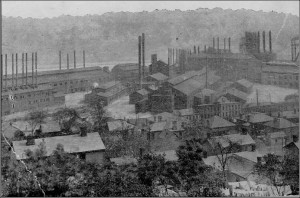For this year’s April A-Z Challenge I am blogging a series of sketches about the free people formerly enslaved on the Cleage plantations in Athens, Tennessee. Most are not related to me by blood, although our families came off of the same plantations – those of Samuel, Alexander and David Cleage. Click on any image to enlarge.
Orlena Cleage was born into slavery about 1855 in McMinn County, Tennessee. I don’t know which Cleages are her people. Orlena appears as a 15 year old in the 1870 Census living with Louis and Malinda (Brigeman) Evans in Athens. Orlena doesn’t have any occupation listed. This is the same household where we found Lydia Cleage in 1870. She never appears with a Cleage family and I cannot find her death certificate.
Orlena Cleage appears once more, on the death certificate of her son, Robert Leonard Brown, born 1893 in Rockwood, Tennessee and died in Jefferson County Ohio in 1945. His father’s name is listed as Iziah Brown. Leonard’s wife, Ida Brown was the informant.

I easily followed Leonard through his life via records but all I am going to tell you is that he had four children – Harold Clark, Gertrude Brown, Robert Brown and Charles Brown. In the 1920 Census Leonard was living in Ohio and was a boarder in his future wife’s home. The other border was Henry Cleage from Tennessee. In 1940 he was a stopper setter in a steel mill
One day when this challenge is over, I will go back and try to tie up all the lose ends and figure which of several Henry Cleage’s that was and if he was related to Orlena, but for tonight I am calling it a wrap.

Huh. I just noticed that the margin of the death certificate reads “This shall be printed legibly or typed with unfading ink.” I guess the doctor who filled this one out didn’t get the memo?
I imagine deciphering terrible hand writing is a major part of doing this kind of research. I know it would be a huge roadblock for me, as I have a hard time reading handwriting (and have lousy handwriting myself). I guess the people recording it at the time probably did this dozens of times a day and didn’t think much of it. Little did they know this would be the only written record of a person’s entire existence 70 years later.
It is a real treat to find a document written legibly. I think they just had terrible handwriting. It’s even worse when you go back to when they had fancy fine handwriting but they made the letters differently than we do – an S looks like an F for instance.
They don’t teach cursive writing in the schools around here any more so my grandchildren’s generation will really have a tough time with old documents and family letters. The experts who came up with the bad plan say that nobody writes any more, everybody uses a computer. Do they someone teach them to write their signature or will that just be written with those fat pens on the little pads in the store, so no need for that either.
Olena is a really pretty name… too bad we don’t know more about her
@TarkabarkaHolgy from
Multicolored Diary – Epics from A to Z
MopDog – 26 Ways to Die in Medieval Hungary
My first job after university was in a steel plant. Despite your link I’m still trying to find out what a stopper setter did. I assume he was setting the stopper in ladles to control the flow of steel from the ladle into moulds, A badly set stopper could result in an uncontrolled flow, loss of steel leading to a poor quality ingot and final steel product.
Bob, I feel like I’m racing along here and not getting to all the details I would like to get. Thank you for helping clarify the stopper setter a bit more.